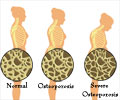Women with the highest postural sway had a two times higher fracture risk compared to women with the lowest postural sway, stated new study.

‘Women with the highest postural sway had a two times higher fracture risk compared to women with the lowest postural sway.’





Postural sway is the tendency of the human body to sway while standing in an erect posture. Studying postural sway is important because it has shown an association with falls, which in turn are an important risk factor for fractures. Fracture risk estimation tools like FRAX (Fracture Risk Assessment Tool, University of Sheffield) use multiple fracture risk factors in order to estimate the chance of a fracture occurring over a certain period. However, the role of postural sway as an independent fracture risk factor has been uncertain. "Our aim was to investigate the association between high postural sway and fractures. In addition, we wanted to study the combined effect of high postural sway and low bone mineral density on fracture risk," says Early Stage Researcher Sarang Qazi, the first author of the new study.
The study was based on the OSTPRE (Kuopio Osteoporosis Risk Factor and Prevention Study) cohort which was initiated in 1989 in order to study bone mineral loss, falls and fractures in postmenopausal women. The cohort consisted of 14,220 peri- and postmenopausal women living in Kuopio, in the eastern part of Finland. Postural sway was measured in 1,568 women from the cohort during 1994-97. The women were followed up for a period of 15 years. At the end of the follow-up period, fracture data were collected through study questionnaires and hospital records.
According to the results, women with the highest postural sway had a two times higher risk for any fracture and for osteoporotic wrist, upper arm, spine or hip fracture compared to women with the lowest postural sway. Further, a combination of high postural sway and low bone mineral density resulted in a five times higher overall fracture risk and an 11 times higher osteoporotic fracture risk compared to the low-risk group. Higher weight was also a significant fracture risk factor.
The study introduces postural sway as a new, independent fracture risk factor. The researchers point out that further research is needed in order to incorporate postural sway into a fracture risk estimation tool. This will improve current methods and help in the early identification of the elderly who are at a greater risk of having a fracture so that required interventions can be carried out in time.
Advertisement















